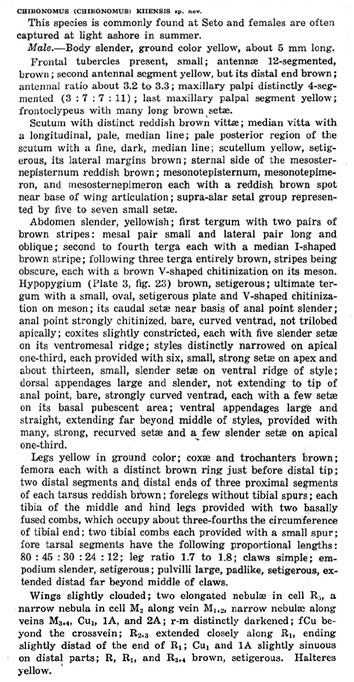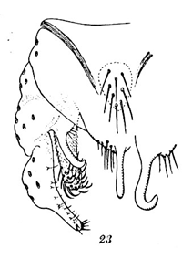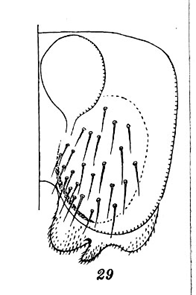Chironomus kiiensis Tokunaga, 1936This name has been considered a junior synonym of C. striatipennis Kieffer 1910 (see under that species), including by Pramual et al. (2016). However those conclusions were biased by the assumption that the previous species identifications were correct. Additional data and analysis of the COI sequences without prior assumption of identity, indicated that this synonymy was not supported, rather there was a complex of probably four species. Re-examination based solely on comparison of DNA sequence regardless of the species identification indicated that C. kiiensis is distinct from C. striatipennis and that at least 3 species were included under this name. Several names have been synonymised with C. kiiensis, but these are distinct species: In Bold Bins: BOLDABZ2474; Note this also includes the bin in which most specimens correctly identified as C. kiiensis have been placed. Tokunaga's original description of the male is given here for information:   Tokunaga's illustration suggests the Superior Volsella is similar to that of the other members of this group, i.e. an E-type, perhaps closest to fig. h of Strenke (1959), but end more sharply curved (although this can vary with mounting – note the difference in the two in the above figure). It also shows the gonostylus as being more swollen and narrowing more sharply over the posterior third. Data from Sasa (1978), Sasa & Hasagawa (1983) are also incorporated. Sasa & Hasagawa note that Superior volsella has a high basal pad, resembling the Einfeldia-group.Body length about 5 mm. Wing length 2.74 (2.36-2.90) mm; width 0.64 (0.55-0.73); abt 3 Scf on brachiolum; 20 setae in squamal fringe. LR 1.71 (1.55-1.82). About 8 setae in a single pale area on TIX.Female: Body length 6.46 (6.12-6.79) mm. Wing length 2.82 (2.76—2.86) mm. AR 3.03 (2.79-3.28).  Molecular: Barcode sequence attributed to this species exists for a number of specimens from a number of areas, and falls into 3 groups. The majority of sequences refer to C. kiiensis (e.g. Otsu City, Honshu), but whether these are the original C. kiiensis cannot be determined. The common form of C. kiiensis differs from C. striatipennis at 12 bases; from the MYT (Thailand population) at 19 bases; from C. nr. kiiensis at 30 bases and from C. strenzkei at 11 bases. Found: Japan - Seto, Wakayama Type locality. |
Modified: 11 September 2025
Access: Unrestricted
Copyright © 2005-2025, Jon Martin.